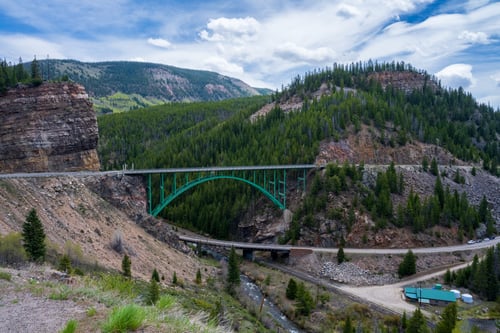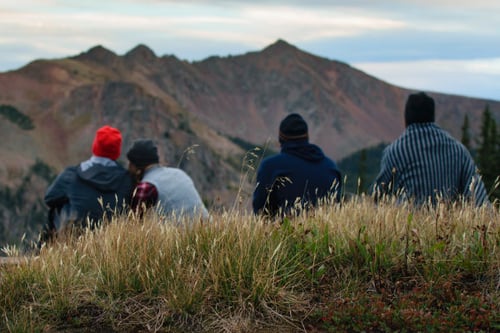The plane’s engines revved, we torpedoed down the runway, and we were airborne. Suddenly I was
looking at all the familiar landmarks of my home from a whole new perspective. In fact, there was my
neighborhood, and my house! The plane made a big turn, heading northeast, and we were looking south
towards Castle Peak. The view from our kitchen window looks north to this unique lava capped
mountain, so this seemed somehow exciting to have a sneak peek at the “other side of the mountain”.
The plane continued to rise and turn, and then we could see Holy Cross and Notch Mountain. The dam
holding back Homestake Reservoir was also visible, and I could make out Homestake Valley and the
Silver Bridge outside of Red Cliff. And yes, I know the bridge is green now, but once upon a time it was
silver, and the locals still refer to it as the Silver Bridge.
 Red Cliff Bridge
Red Cliff Bridge
As we flew further away from home, I recognized less of the landmarks. But my husband, a 5 th
generation Colorado native, was still calling out the landmarks. He pointed out Turquoise Lake, and Twin
Lakes, as the plane turned south. And then further to the east, he recognized Eleven Mile Reservoir, and
struggled to remember the name of the lake west of it. Finally the lakes and mountains were replaced
by the sprawling city of Colorado Springs and its suburbs, and then the flat plains and clouds took over
our field of view as we settled into the monotony of the flight.
We spent the week in Florida, and while I wasn’t conscious of it at first, as the week went on, I missed
Colorado. I missed the green rolling hills, the cool evenings, the clear skies, and the afternoon
thunderstorms. I missed being able to drive with the windows open. But mostly, I missed the feel of
home.
 Hikers Resting near Vail
Hikers Resting near Vail
I watch the national news each night, and I’m always struck by how people are so connected to their
place, wherever it may be. When tragedy strikes, the people are always proud of where they live, and
they come together as a community in ways that they probably couldn’t even imagine before the
tragedy struck. You hear people say things like, “Such-and-such is our home, and we will rebuild.” This
feeling of belonging to a specific piece of land, of having a home; this is what we call Sense of Place.
The way that people love their homeland, wherever it may be, is a testament to the diversity of people
that call our planet home. I drive across the plains of Nebraska or Kansas, and I wonder how people can
live in such a flat, windswept land. And I wonder how people can survive in a big city like New York or
L.A., where they are surrounded by a sea of cement and asphalt? But in all of these places, people
survive and thrive even.
Sense of Place is not the kind of thing that can be taught, but it is learned. It is learned through
experience in a place, and it is felt through connections that we can’t quite name. It’s one of those
things that we don’t think about every day, and often we don’t really appreciate the place we live in
until we are away from it. Or until something happens to it. I wonder, too, if some of the problems in
our world are simply a problem of misplaced people. Maybe we’re all meant to be connected to a
particular place. Some of us are just lucky enough to be born there, while the rest of us have to find
home.
I think the famous Judy Garland said it best, as little ole Dorothy Gale from Kansas, “There’s no place like
home.” And while I am clearly biased, I think we all agree that we live in one of the best, most beautiful
places on earth. Wherever that may be.
Jaymee Squires is the Director of Graduate Programs and Senior Faculty Advisor at Walking Mountains
Science Center in Avon. This article was originally published in 2015.









